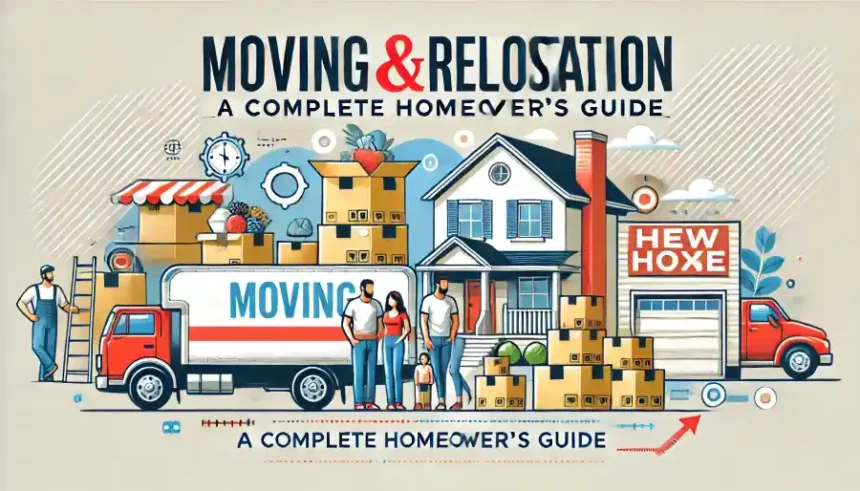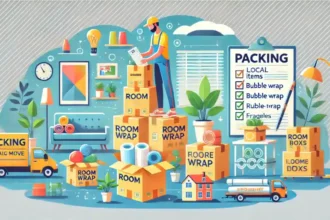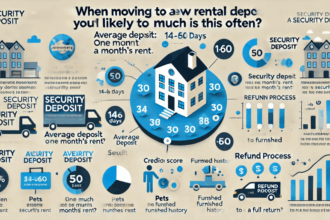Did you know the average person in the U.S. moves nearly 12 times in their lifetime? Whether you’re relocating for a new job, upgrading your living space, or chasing a dream, the journey of moving and relocation can feel like a whirlwind of excitement and stress.
This comprehensive guide is designed to make moving and relocation manageable, whether you’re tackling a local move, a long-distance adventure, or even an international transition. You’ll learn essential tips for packing, planning, and adjusting to your new home without the overwhelm.
With the right strategies and resources, moving and relocation can be transformed from a chaotic ordeal into an exciting step toward fresh opportunities.
Ready to take the first step toward a stress-free move? Let’s dive in!
Pre-Move Planning: Your Key to a Smooth Moving & Relocation Experience
Effective pre-move planning is the foundation of a successful moving and relocation journey. By organizing tasks, budgeting, and preparing in advance, you can significantly reduce the stress associated with moving. Whether you’re relocating across town or across the country, this guide will help you plan every detail.
1. Create a Moving Checklist
A moving checklist is essential for staying organized. It ensures you don’t overlook critical tasks. Include items like:
- Scheduling moving services or renting a truck.
- Gathering packing supplies.
- Notifying utilities and services of your change of address.
2. Budgeting for Moving Expenses
Moving can be expensive, but budgeting helps you manage costs effectively. Key expenses include:
- Professional Movers: Research and compare moving companies for the best rates.
- DIY Costs: Truck rentals, gas, and packing supplies.
- Hidden Costs: Storage fees, cleaning services, or insurance.
3. Decluttering Before Moving
Save money and effort by decluttering your belongings before packing. Steps to declutter:
- Categorize Items: Separate items into “keep,” “donate,” and “discard.”
- Read: “How to declutter before a long-distance move.”
- Sell Unwanted Items: Platforms like Facebook Marketplace or garage sales can help recoup costs.
4. Finding a New Home
When moving, finding the right home in the right neighborhood is crucial. Research:
- School districts, especially if you’re moving with kids.
- Proximity to amenities like grocery stores and healthcare.
- “Finding pet-friendly apartments” if you have pets.
- Conducting home inspections to avoid unexpected surprises.
5. Decide on DIY vs. Professional Movers
Choosing between DIY and professional movers depends on your budget and timeline:
- DIY: Great for short-distance moves or small loads.
- Professional Movers: Recommended for long-distance moves, fragile items, or larger households.
Packing & Preparing for the Move
Packing is one of the most time-consuming aspects of moving and relocation. From fragile items to bulky furniture, each item requires careful attention. With the right packing techniques, you can protect your belongings and make unpacking a breeze.
In this section, we’ll cover:
- Efficient packing strategies.
- Tips for packing fragile and bulky items.
- DIY hacks to save time and money.
1. Gather Essential Packing Supplies
Before you begin, make sure you have all necessary packing materials:
- Sturdy boxes in various sizes.
- Packing tape and scissors.
- Bubble wrap and packing paper for fragile items.
- Labels and markers for organization.
2. Packing Tips for Specific Items
Packing Fragile Items
Protect breakable items with these tips:
- Use bubble wrap or soft clothing as padding.
- Pack dishes vertically in small boxes.
- Fill empty spaces with packing paper to prevent movement.
Packing Clothes Efficiently
- Roll clothes to save space and reduce wrinkles.
- Use wardrobe boxes for hanging garments.
- Pack off-season clothes separately for easier unpacking.
Packing Kitchen Essentials
- Wrap glassware individually and use dividers for plates.
- Pack appliances in their original boxes if available.
- Label boxes with “Fragile” and “Kitchen” for easy handling.
3. How to Disassemble Furniture for Moving
Moving large furniture? Follow these steps:
- Take apart beds, tables, and other bulky items.
- Keep screws and small parts in labeled bags.
- Use blankets or padding to protect disassembled pieces.
4. Decluttering While Packing
Save space and reduce moving costs by decluttering. As you pack:
- Sort items into “keep,” “donate,” and “discard” piles.
- Donate or sell items you no longer need.
5. Label and Organize Boxes
Proper labeling ensures smooth unpacking:
- Use color-coded labels for each room.
- Write detailed descriptions on boxes (e.g., “Kitchen – Pots and Pans”).
- Mark essential boxes as “Open First.”
DIY Packing Hacks for Moving
- Use towels and blankets as padding for fragile items.
- Store small items in resealable bags or plastic containers.
- Use suitcases for heavy items like books.
For more information read: How to Pack for a Local Move?
Moving Day Tips: Ensuring a Smooth Moving & Relocation Experience
Moving day has finally arrived! After weeks of preparation, the big day can feel overwhelming. Proper planning and organization are key to making your moving day a success. This guide will help you navigate common moving day challenges, ensuring your relocation goes as smoothly as possible.
1. Prepare an Essentials Kit
An essentials kit will keep important items accessible throughout the move. Include:
- Toiletries (toothbrush, toothpaste, etc.).
- Change of clothes and comfortable shoes.
- Chargers for electronics.
- Snacks, water, and medications.
- Important documents (IDs, lease agreements, etc.).
2. Manage Movers and Logistics
Whether using professional movers or handling the move yourself, organization is key:
- Confirm the arrival time of movers or the truck rental.
- Supervise the loading process to ensure items are handled with care.
- Provide clear instructions on which items need extra attention (e.g., fragile boxes).
3. Stay Organized During Loading and Unloading
- Use color-coded labels or markers to identify boxes by room.
- Load heavier items first to balance the moving truck.
- Ensure fragile boxes are placed securely to prevent damage.
4. Handle Kids and Pets
Moving day can be hectic for families with kids or pets. Here’s how to manage:
- Arrange childcare or a pet sitter for the day, if possible.
- Set up a quiet space with familiar toys or items to keep them calm.
Read “Tips for moving with a newborn” or “Moving across the country with pets” for specialized advice.
5. Be Prepared for Last-Minute Challenges
Despite the best planning, unexpected situations may arise. Tips to handle these include:
- Keep a basic toolkit handy for quick fixes (e.g., screwdriver, duct tape).
- Have a contact list of movers, landlords, and utility providers.
- Stay flexible and patient to manage unforeseen delays.
Post-Move Settling In: Tips to Adjust After Moving & Relocation
Congratulations! You’ve successfully completed your moving and relocation journey. Now comes the next chapter: settling into your new home. Adjusting after a move can feel overwhelming, but with a clear plan, you can quickly transform your new space into a comfortable and welcoming home.
1. Start with an Unpacking Plan
Unpacking efficiently will help you feel settled faster:
- Prioritize essential rooms like the kitchen, bathroom, and bedroom.
- Use a pre-labeled system to unpack room by room.
- Dispose of packing materials as you go to avoid clutter.
2. Change Your Address
Notifying key institutions of your move is crucial. Update your address with:
- Government agencies (e.g., DMV, USPS).
- Banks and credit card companies.
- Healthcare providers and insurance companies.
- Subscription services and online retailers.
3. Set Up Utilities
Ensure your new home is fully functional by transferring or setting up utilities:
- Electricity, water, and gas.
- Internet, cable, and phone services.
- Trash and recycling collection.
- Consider scheduling installations before moving day to avoid delays.
4. Explore Your New Neighborhood
Familiarizing yourself with your surroundings will help you feel at home:
- Locate nearby grocery stores, pharmacies, and restaurants.
- Explore parks, recreational facilities, or local attractions.
- Introduce yourself to neighbors for a sense of community.
5. Adjusting Emotionally
Moving can be an emotional experience, especially if you’re far from friends and family. Tips to ease the transition:
- Decorate your space to make it feel personal and familiar.
- Stay in touch with loved ones through regular calls or visits.
- Join local groups or attend community events to make new friends.
Specialized Relocation Guides
Every move is unique, and some situations require specialized planning and strategies. Whether you’re relocating across the globe, moving with kids, or downsizing for retirement, these guides provide expert advice to meet your specific moving and relocation needs.
1. Long-Distance Moving Tips
Planning a cross-country relocation? Here’s how to simplify the process:
- Create a detailed timeline to avoid last-minute stress.
- Research and hire reliable long-distance movers.
- Pack strategically to minimize damage during transport.
Read “How to declutter before a long-distance move.”
2. International Moving Guide
Moving internationally comes with unique challenges. Key steps include:
- Understand customs regulations and required documentation.
- Decide between air or sea freight for shipping belongings.
- Research local laws and cultural norms in your destination country.
- Manage culture shock with language learning and community building.
3. Senior Relocation & Downsizing Tips
Helping a senior family member move? Consider these tips:
- Plan early and involve the senior in key decisions.
- Focus on downsizing by prioritizing sentimental and essential items.
- Choose a new home that meets accessibility needs.
Read “Downsizing tips for seniors” to address specific concerns.
4. Moving with Kids
Relocating with children requires careful planning. Tips to make the transition easier:
- Talk to your kids about the move early to address concerns.
- Involve them in packing and organizing their belongings.
- Research schools, daycare, and family-friendly amenities in the new area.
Read: “Tips for moving with a newborn” or “School information for relocation.”
5. Relocating with Pets
Pets need special care during a move. Ensure their comfort by:
- Scheduling vet visits for health checks and travel documentation.
- Packing a pet essentials kit with food, water, and familiar items.
- Finding pet-friendly housing and parks in your new area.
Read “Finding pet-friendly apartments” or “Moving across the country with pets.”
Moving & Relocation Resources: Find the Help You Need for Your Move
Navigating a successful moving and relocation process often requires more than just planning—it also involves using the right resources. From finding reliable movers to securing moving insurance, this section provides an overview of the tools and services you’ll need for a seamless relocation.
1. Choosing a Moving Company
Selecting the right movers is critical for a stress-free move:
- Research local and long-distance moving companies.
- Compare quotes to ensure competitive pricing.
- Check reviews and ask for referrals.
- Look for companies offering moving insurance for added peace of mind.
Read: “Finding reliable movers in [city name].”
2. Understanding Moving Insurance
Protecting your belongings during the move is essential. Here’s what to know:
- Types of coverage: Basic liability vs. full-value protection.
- How to file a claim for damaged or lost items.
- Questions to ask your moving company about their insurance policies.
3. DIY Moving Resources
For those planning a DIY move, consider these tools:
- Truck rental services like U-Haul or Budget.
- Packing supplies available at hardware or online stores.
- Apps to organize and track moving tasks, such as MoveAdvisor or Sortly.
Read: “DIY moving supplies checklist.”
4. Online Platforms for Decluttering
Decluttering can help reduce moving costs. Use these platforms to sell or donate unwanted items:
- Facebook Marketplace for selling locally.
- Donation centers like Goodwill or Habitat for Humanity.
- Apps like OfferUp and Letgo for quick sales.
5. Seasonal Moving Considerations
Timing your move can impact costs and convenience:
- Best Time of Year to Move: Consider off-peak seasons like fall or winter for better deals.
- Weather-Related Prep: Plan for heat, rain, or snow depending on the season.
Read: “Best time of year to move for affordability.”
Bonus Tips for Using Resources Effectively
- Start your research early to secure your preferred movers or rental trucks.
- Bundle services (like packing and moving) for potential discounts.
- Leverage online reviews and ratings to make informed decisions.
Bonus Tips & Hacks
Moving can feel overwhelming, but with the right tips and hacks, you can simplify the process and even save money. These bonus tips are designed to streamline your moving and relocation experience, helping you avoid common pitfalls and make the most of your time.
1. Save Money with DIY Packing Hacks
- Use household items like towels and blankets as padding for fragile items.
- Pack heavy items like books in rolling suitcases to avoid lifting strain.
- Use vacuum-seal bags for clothing and bedding to save space.
2. Simplify the Packing Process
- Label boxes on all sides for easy identification, even in a stacked pile.
- Keep cables and cords organized by wrapping them and placing them in labeled ziplock bags.
- Use plastic wrap to secure drawers and shelves without emptying them.
3. Maximize Efficiency on Moving Day
- Load boxes into the moving truck by room to simplify unloading.
- Pack an “essentials box” with items like toiletries, chargers, and snacks.
- Take photos of complex setups, such as electronic connections, for easy reassembly.
4. Avoid Common Moving Mistakes
- Don’t overpack large boxes—they become too heavy to move safely.
- Avoid last-minute packing by starting at least 4 weeks in advance.
- Double-check your new home for proper utilities setup before moving day.
5. Eco-Friendly Moving Hacks
- Rent reusable moving boxes instead of buying cardboard.
- Donate unwanted items to reduce waste and help your community.
- Recycle packing materials or use biodegradable alternatives.
Moving & Relocation: Wrapping Up Your Journey with Confidence
Moving and relocation can be one of life’s most exciting yet challenging transitions. Whether you’re moving locally or internationally, the process requires thoughtful planning, organization, and a little creativity. If you’re unsure about what qualifies as a local move, check out our guide: What Is Considered a Local Move? for detailed insights.
By following the tips and strategies outlined in this guide, you’re now equipped to:
- Plan effectively with a moving checklist.
- Pack and prepare efficiently, saving time and money.
- Navigate moving day like a pro.
- Settle into your new home with ease.
Remember, every move is a fresh start and an opportunity for growth. By staying organized and positive, you can make the most of your moving and relocation experience.
Key Takeaways
- Plan Ahead: Start early with a checklist to stay on track.
- Pack Smart: Use creative hacks to save space and protect belongings.
- Embrace the Change: Explore your new neighborhood and create a home you love.
If you’re ready to take the next step in your moving and relocation journey, download our free Ultimate Moving Checklist or contact us for expert advice tailored to your needs.















